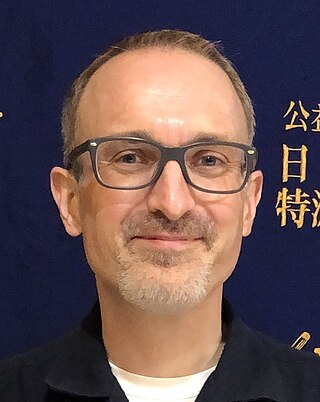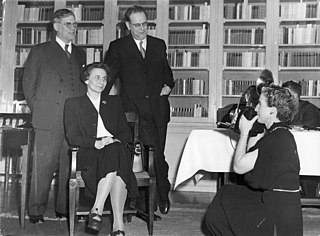
The Japan Times is Japan's largest and oldest English-language daily newspaper. It is published by The Japan Times, Ltd., a subsidiary of News2u Holdings, Inc. It is headquartered in the Kioicho Building in Kioicho, Chiyoda, Tokyo.

The Foreign Correspondents' Club (FCC) in Hong Kong is a members-only club and meeting place for the media, business and diplomatic community. It is located at 2 Lower Albert Road in Central, next to the Hong Kong Fringe Club, and they both occupy the Old Dairy Farm Depot at the top of Ice House Street, one of the few remaining colonial buildings in the Central district.

Thomas William Lamont Jr. was an American banker.

Ethel Lois Payne was an American journalist, editor, and foreign correspondent. Known as the "First Lady of the Black Press," she fulfilled many roles over her career, including columnist, commentator, lecturer, and freelance writer. She combined advocacy with journalism as she reported on the Civil Rights Movement during the 1950s and 1960s. Her perspective as an African American woman informed her work, and she became known for asking questions others dared not ask.
Foreign Correspondents' Club is a group of clubs for foreign correspondents and other journalists. Some clubs are members only, and some are open to the public.

Steven L. Herman is a journalist and author, and, as of June 2022, Voice of America's chief national correspondent. From 2017 through 2021, Herman was senior White House correspondent and subsequently VOA's White House bureau chief.

Louis Carlet is the founder of Tozen, a union representing both Japanese and migrant workers, including foreign language teachers, bank and newspaper workers.

Women in journalism are individuals who participate in journalism. As journalism became a profession, women were restricted by custom from access to journalism occupations, and faced significant discrimination within the profession. Nevertheless, women operated as editors, reporters, sports analysts and journalists even before the 1890s in some countries as far back as the 18th-century.
First Into Nagasaki: The Censored Eyewitness Dispatches on Post-Atomic Japan and Its Prisoners of War is a collection of reports by Chicago Daily News foreign correspondent George Weller. Originally written in 1945, but not approved for publication by Gen. Douglas MacArthur's military censors. The reports were collected and edited by the author's son Anthony Weller, and published for the first time in 2006.
Philippine News Agency (PNA) is the official news agency of the Philippine government. PNA is under the supervision and control of the News and Information Bureau, an attached agency of the Presidential Communications Operations Office. It was established on March 1, 1973, by President Ferdinand Marcos, and currently has its headquarters in Quezon City.

Seymour Topping was an American journalist best known for his work as a foreign correspondent covering wars in China, Korea, Vietnam, Laos, and Cambodia, and the Cold War in Europe. From 1969 to 1986, he was the second senior-most editor at The New York Times. At the time of his death, he was the San Paolo Professor Emeritus of International Journalism at Columbia University, where he also served as administrator of the Pulitzer Prizes from 1993 to 2002.
Donald Kirk is a veteran correspondent and author on conflict and crisis from Southeast Asia to the Middle East to Northeast Asia. Kirk has covered wars from Vietnam to Iraq, focusing on political, diplomatic, economic and social as well as military issues. He is also known for his reporting on North Korea, including the nuclear crisis, human rights and payoffs from South to North Korea preceding the June 2000 inter-Korean summit.[1]
Selig Seidenman Harrison was a scholar and journalist, who specialized in South Asia and East Asia. He was the Director of the Asia Program and a senior fellow at the Center for International Policy, and a senior scholar of the Woodrow Wilson International Center for Scholars. He was also a member of the Afghanistan Study Group. He wrote five books on Asian affairs and U.S. relations with Asia. His last book, Korean Endgame: A Strategy for Reunification and U.S. Disengagement, won the 2002 award of the Association of American Publishers for the best Professional/Scholarly Book in Government and Political Science.

Jon Mitchell is a Welsh journalist and author residing in Yokohama, Japan. Mitchell has written widely about Okinawa, especially on issues created by the ongoing presence of the United States Armed Forces. He was awarded the inaugural Foreign Correspondents' Club of Japan's Freedom of the Press Lifetime Achievement Award for this work in 2015. In 2021, Mitchell's book, Poisoning the Pacific: The US Military's Secret Dumping of Plutonium, Chemical Weapons, and Agent Orange, won Second Place in the Society of Environmental Journalists annual awards for Reporting on the Environment.

Roy Rowan was an American foreign correspondent, editor, and author. He reported on the 1949 revolution that led to the founding of the People's Republic of China, as well as the Korean and Vietnam Wars. Rowan worked for Time-Life and its successor media company, Time-Warner, for more than 30 years. From late 1959 to 1970 he was Life magazine's assistant managing editor in charge of news. In 1972, Rowan returned to Time-Life and served as Time magazine's bureau chief for Asia and Australia until 1978. Roy Rowan spent the latter part of his career from 1978 to 2015 as a feature story writer for Time magazine and on the Board of Editors of Fortune magazine while writing 10 published books on a wide variety of topics.
The Associated Negro Press (ANP) was an American news service founded in 1919 in Chicago, Illinois by Claude Albert Barnett. The ANP had correspondents, writers, reporters in all major centers of the black population in the United States of America. It supplied news stories, opinions, columns, feature essays, book and movie reviews, critical and comprehensive coverage of events, personalities, and institutions relevant to black Americans. As the ANP grew into a global network. It supplied the vast majority of black newspapers with twice weekly packets.

Jackie Martin (1903–1969) was a photojournalist and newspaper editor who achieved firsts and near-firsts as a woman in the American workforce. She was the first woman to become art director and picture editor of a metropolitan newspaper and the first to be accepted to membership in the prestigious White House Press Corps. She was also the first woman to be hired as sports editor at a major metropolitan daily paper and first, or one of the first, to manage and coach a professional basketball team. She achieved recognition as the first official photographer and public relations officer for the Women's Army Auxiliary Corps and the first to wear a WAAC uniform. She received awards for her photography, for her work as a war correspondent, and for her internationally-recognized lifetime achievements in journalism.
Lewis M. Simons is an American Pulitzer Prize-winning correspondent on foreign affairs throughout Southeast Asia and the Middle East.
















